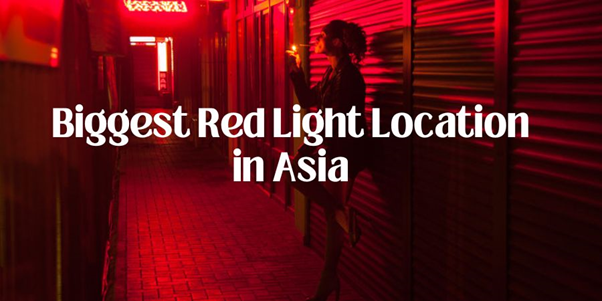Asia hosts the largest and most well-known red light districts in the world. These make places to gather people from within the community and tourists, carrying a complex mix of legal and illegal activities. Ranging from high-end establishments to entirely underground scenes, red-light locations in Asia are as diverse as the continent itself. Cultural, legal, and social dynamics differ considerably in these areas, such that every place is uniquely different from the others. In this article, we will explore the biggest red light location in Asia as well as some of the most popular red light areas across the continent.
Notoriety of Red Light Locations in Asia
To name a few, when one talks about red light locations in Asia, they immediately relate to such cities as Bangkok and Manila, but first, of course, Tokyo and quite a number of others. Such cities have some of the most popular and infamous red-light areas globally, attracting millions of visitors each year. And red-light areas are not some kind of illicit activities alone; many of these areas also feature a mix of entertainment, nightlife, and plenty of services. These locations have popularized them to be among the greatest tourist attractions and, in turn, entrenched their place within the broader cultural geography of Asia.
Now, let us dive into some of the most dominant red-light destinations in Asia.
1. Bangkok’s Patpong: Asia’s Largest Red Light Destination
The red light location at Patpong is one of the most famous and the biggest in Asia. Patpong is a rather famous nightlife destination today, as well as forming a big part of the identity of the city itself. Situated in the middle of Bangkok, Patpong is one of the most vibrant districts of the city. It is full of bars, nightclubs, and go-go bars catering to tourists from around the world.
Contrary to most other red light districts, however, Patpong remains tolerated by local authorities and remains a legal part of Thailand’s entertainment business. Patpong also offers night markets with street food for evening snacks, showing a good balance between old Thai style and a more provocative modern atmosphere.
Apart from Patpong, another hub was Soi Cowboy and Nana Plaza, making the city popular as a destination for adult entertainment. These famous red light areas define the face of the city.
2. Delhi: An emerging red light destination in India
Probably one of the most infamous red light districts in India, GB Road exists in the Central Delhi. The sex industry scenes on GB Road are pulsating but also often inflammatory. While the area does not enjoy a similar legal status as Bangkok’s Patpong or Tokyo’s Kabukicho, it remains arguably the country’s most visible red light spot.
Delhi also offers expensive Delhi escort services for high-profile and well-heeled customers. Some of the most popular services include Escorts in Aerocity. Even though they work with a certain level of discretion, these services ensure that there is always something new and different as an alternative to the more traditional red light areas like GB Road.
Delhi red-light district serves as a beacon to signal the complexity of sex work in India. Even though the place has legal and social stigmatization, it is said that the place survives well, providing employment to thousands of people and feeding the country’s underground economy.
3. Manila’s Angeles City: Most popular Red Light Area in the Philippines
Angeles City is one of the most visited red light areas in Asia. The red light area near Clark Air Base in the Philippines originally gained notoriety because of the American military presence during the Vietnam War. Today, that once notorious red light area has transformed itself into a very thriving entertainment hub with numerous go-go bars, adult clubs, and so many other establishments that cater to nightlife and adult services.
Though the red light area at Angeles City is lawful, it has also drawn significant criticism due to its problems in human trafficking and exploitation. However, it is considered one of the largest red light destination sites in Asia, attracting a diverse crowd of tourists from around the world.
4. Tokyo’s Kabukicho: The Biggest Red Light Area in Japan
Tokyo’s Kabukicho is one of Asia’s largest and most famous red light districts. Cabukicho is located in the center of the Shinjuku ward. It is an entertainment district full of host and hostess clubs, love hotels, restaurants, nightclubs, and almost every other form of adult entertainment. While primarily synonymous with nighttime, Kabukicho features an assortment of non-porn entertainment venues that make this a district for all ages.
Over time, the Japanese government has made efforts to reinvent Kabukicho by eradicating most of the illegal activities within the district. However, up to today many people go to this district because of its red light reputation.

5. Singapore’s Geylang: A Red Light location with a Twist
Comparatively speaking, Singapore’s Geylang district does not have the glamour associated with Bangkok nor the neon lights of Tokyo. Instead, this is a relatively low-profile Asian red light location but strictly regulated by the government. Singapore legalized prostitution but controlled the activity within designated bounds. Geylang is one of the few areas in Singapore where sexual services are allowed, and the authorities check if establishments are within bounds of the law.
Unlike other red light places, Geylang also serves as a residential and commercial area. There is a contrast between the red light industry of Geylang and everyday community life, making the place have a unique character more than other red light areas in Asia.
6. Mumbai’s Kamathipura: One of the Oldest Red Light Areas in Asia
It is located in Mumbai, India, and Kamathipura is among Asia’s oldest and largest red light areas. The red light area has existed since the 19th century when this was a British colony. Like the Indian red light district GB Road in Delhi, controversy over exploitation and human trafficking has surrounded Kamathipura, but Kamathipura is an important component of the city of Mumbai’s history and culture.
Over time, the place evolved because rehabilitation programs were opened to facilitate prostitutes, guiding them to other ways of livelihood. However, despite such interventions, Kamathipura remains one of Asia’s premier red light locations and continues to attract attention from researchers, NGOs, and the media.
The Asia Red Light Sites: Complexity
Many red light areas in Asia are controversial but on the other hand, they are an important and integral part of the cultural and economic landscape of their respective cities. Areas such as these offer a whole range of services beyond mere adult entertainment – food and drink, shopping and nightlife. However, it is essential that all these issues with regard to legality, safety and exploitation must be recognized.
For instance, although red light areas exist elsewhere like in Bangkok, Tokyo, and Manila, those are areas of growing pressure due to their connections with human trafficking and other illegal ventures. Most reform attempts here tend to straddle on both sides; observing the rights of sex workers with attempts to crush illegal enterprises.
Conclusion: The Biggest and Most Popular Red Light Areas in Asia
Asia’s red-light locations are as varied as they are famous, each with their distinctive combinational cultural, entertainment, and controversy mix. Patpong in Bangkok is usually regarded as the largest red light district in Asia, though others, such as Kabukicho in Tokyo, Angeles City in the Philippines, and GB Road in Delhi, also play a significant role in shaping the region’s red-light landscape.
In fact, red light areas aren’t for all, especially for those looking for very discreet experiences. Other services exist like Escorts in Aerocity catering to a more upscale crowd and give an impression of how sex work and adult entertainment is evolving face in Asia: there’s growing interest in discretion and professionalism.
Asia’s red light areas are deep interwoven with the history, economy, and social tissue of their respective cities. Whether through the law or the underground, they attract tourists, government officials, and residents alike, making them integral parts of Asia’s urban experience.










